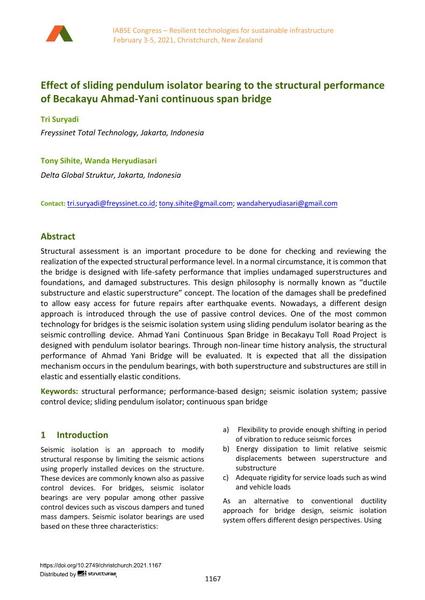Effect of sliding pendulum isolator bearing to the structural performance of Becakayu Ahmad-Yani continuous span bridge

|
|
|||||||||||
Bibliografische Angaben
| Autor(en): |
Tri Suryadi
(Freyssinet Total Technology, Jakarta, Indonesia)
Tony Sihite (Delta Global Struktur, Jakarta, Indonesia) Wanda Heryudiasari (Delta Global Struktur, Jakarta, Indonesia) |
||||
|---|---|---|---|---|---|
| Medium: | Tagungsbeitrag | ||||
| Sprache(n): | Englisch | ||||
| Tagung: | IABSE Congress: Resilient technologies for sustainable infrastructure, Christchurch, New Zealand, 3-5 February 2021 | ||||
| Veröffentlicht in: | IABSE Congress Christchurch 2020 | ||||
|
|||||
| Seite(n): | 1167-1174 | ||||
| Anzahl der Seiten (im PDF): | 8 | ||||
| DOI: | 10.2749/christchurch.2021.1167 | ||||
| Abstrakt: |
Structural assessment is an important procedure to be done for checking and reviewing the realization of the expected structural performance level. In a normal circumstance, it is common that the bridge is designed with life-safety performance that implies undamaged superstructures and foundations, and damaged substructures. This design philosophy is normally known as “ductile substructure and elastic superstructure” concept. The location of the damages shall be predefined to allow easy access for future repairs after earthquake events. Nowadays, a different design approach is introduced through the use of passive control devices. One of the most common technology for bridges is the seismic isolation system using sliding pendulum isolator bearing as the seismic controlling device. Ahmad Yani Continuous Span Bridge in Becakayu Toll Road Project is designed with pendulum isolator bearings. Through non-linear time history analysis, the structural performance of Ahmad Yani Bridge will be evaluated. It is expected that all the dissipation mechanism occurs in the pendulum bearings, with both superstructure and substructures are still in elastic and essentially elastic conditions. |
||||
